Log in or create new account to save this product to your wishlist.
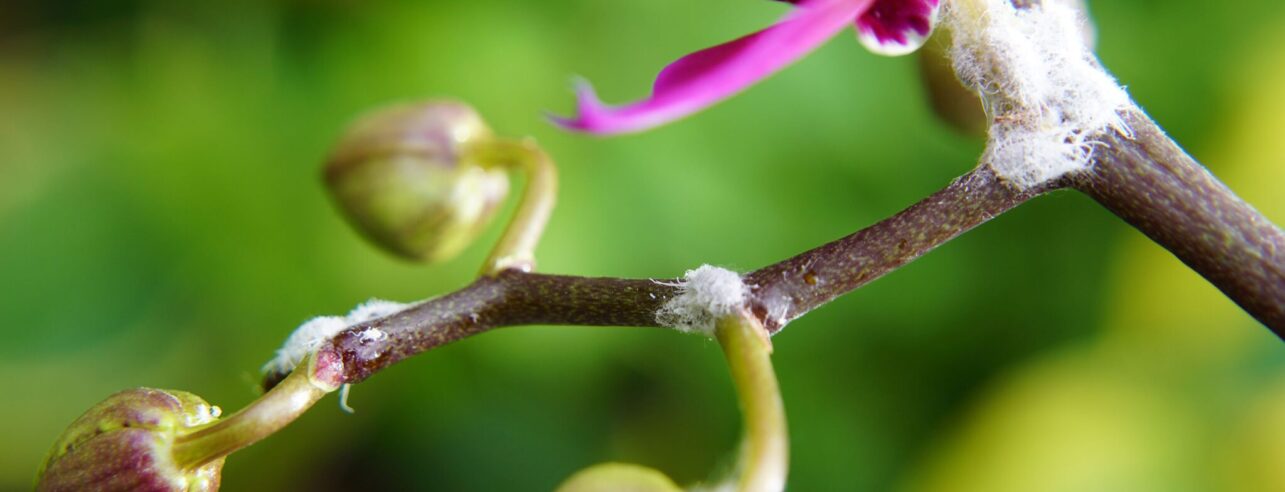
How to Prevent and Control Mealybugs on your Plants (and aftercare)
Mealybugs look like little fluffy specks of mould, but they'll quickly destroy your house plants or greenhouse plants. Learn how to spot an infestation and what to do to prevent the problem from spreading.
🌱 All important maintenance moments for your lawn during the year. Leave your email and we will send you the lawn calendar for free.
Enter your email
Receive the lawn calendar in the mail
Enjoy a green lawn all year round!

- Order by 2PM = shipped today
- 250.000+ satisfied customers!
- 60 day satisfaction guarantee
Are you spotting white, woolly patches on your plants, around plant stems? Have you seen little furry bugs with many legs and long tails? It sounds like you might have a mealybug infestation! Don’t panic; the problem is treatable, but act fast!
- Mealybugs at a glance
- Why are mealybugs a problem?
- How to identify a mealybug problem.
- How a mealybug infestation spreads
- Fighting mealybugs
- Natural home remedies against mealybugs
- Beneficial insects to tackle mealybugs
- Preventing a reinfection!
- Mealybugs and ants — a match made in insect heaven
- Tips & Tricks in the fight against mealybugs
- Chemical solutions to mealybug infestations
- Helping your plants recover after infection
- FAQs
Mealybugs feed on plant sap, leaving a sticky honeydew as they feed. This sticky substance attracts mould, which can damage your plants (or even cause plant death!).
This article is about how to prevent and control mealybugs on your plants and how to help your plants recover after infestation.
Ready? Let’s go!
Mealybugs at a glance
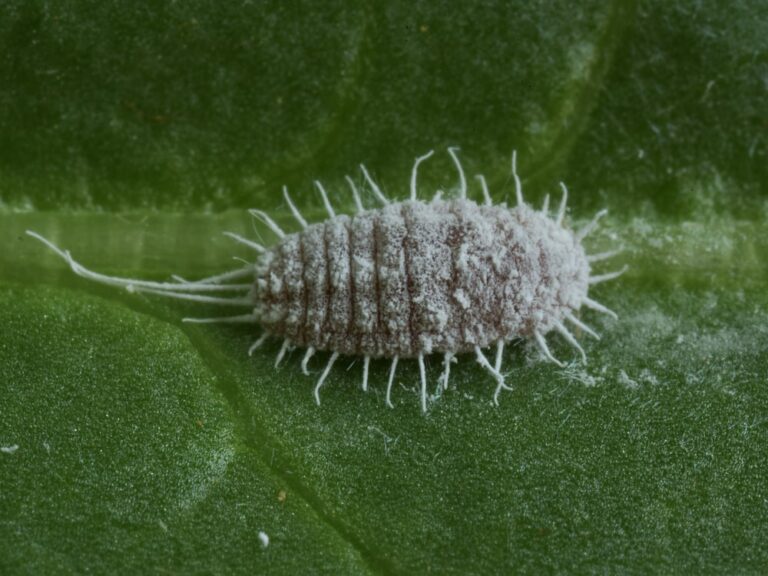
Mealybugs are tiny insects related to scaly aphids. Their body is between 1 and 10mm long, covered in a waxy layer from which threads protrude, appearing like strands of wool.
These pests are commonly found on greenhouse plants and houseplants, feed on plant sap, and reproduce quickly! A single female can lay 600 eggs over the course of its 40-day life.
Their presence can attract ants, which feed off the honeydew mealybugs leave behind.
Why are mealybugs a problem?
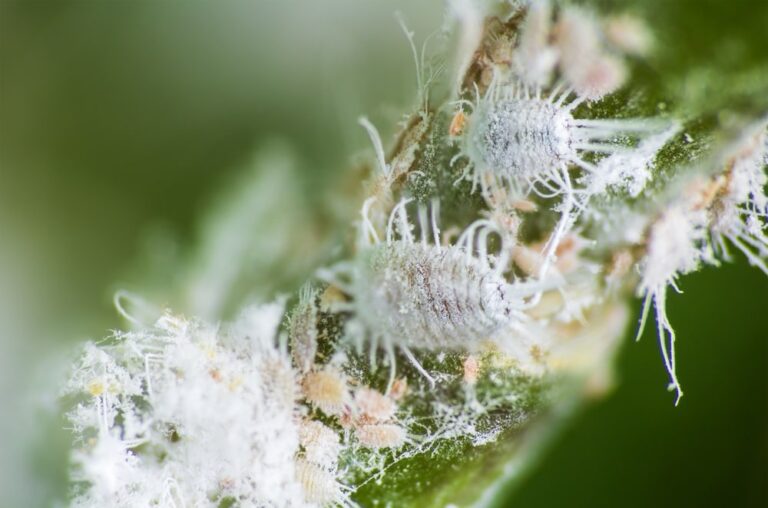
As mentioned, these tiny bugs feed on plant sap, weakening the plant and often causing a prompt death.
These little critters will take what they can from one plant, then move on to the next when they’ve depleted their food source — which means a mealybug presence can quickly turn into an infestation.
How to identify a mealybug problem.
Depending on their size, mealybugs can be challenging to identify because you may confuse them for dirt or mould.
However, they’re often found underneath leaves or at the axils (where the leaf sprouts from the stem), leaving white, fluffy-looking excretions that look like cotton wool.
One of the first signs of infestation is yellowing or wilting leaves. If your plant looks sad, inspect it closely for the telltale signs of white fluff. You may also spot a sticky substance on the leaf surface — all signs that mealybugs are making a meal of your garden or house plants.
How a mealybug infestation spreads
These tiny little bugs can spread by the wind or on wildlife — but we don’t get away with it either because we can spread mealybugs if they come into contact with our clothes.
But one of the main ways that plants spread the infection is through touch, so if your plants are large and spreading out, it’s a good idea to prune them back a little to leave air circulation space around each plant.
Remove infected plants away from others to prevent further spread. The plant will likely die anyway, so always act fast.
Plants that are prone to mealybugs
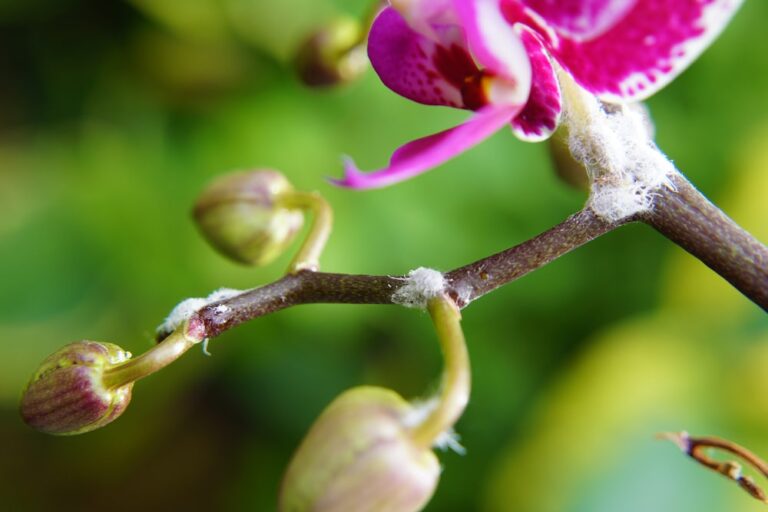
Some plants are more prone to mealybug infestations than others. The following species are particularly susceptible:
- Orchids
- Succulents
- Cactuses
- Poinsettia
- Rubber plants
- Hydrangea
- Fruit trees
- Grasses
Orchids and hydrangeas are particularly susceptible, sucking the juice from their leaves, which leads to growth disorders and, ultimately, the plant’s demise.
You’ll likely see damage at the bottom tip of the leaves first — so keep a close eye on your plants!
Fighting mealybugs
While there are commercial chemical pesticides available, I always recommend those as a last resort. There are plenty of natural home remedies, and they work!
So, before spraying chemicals around your home or garden, always try the natural approaches first.
Natural home remedies against mealybugs
Vinegar
Vinegar is a natural insecticide that will wipe out the bugs without damaging your plant.
Mix equal parts vinegar and water, then use a sprayer to treat affected areas of the plant.
Baking soda
This handy store cupboard essential has a wide range of uses. Sure, baking soda (aka bicarbonate of soda) can leaven your bread and cookies, but it is also an effective drain cleaner, clothing whitener, and — you’ve guessed it — mealybug killer.
Make a paste of baking soda and water and paint it onto the affected areas. Leave it to work for a couple of hours, then rinse it away thoroughly.
Garlic

Not only will garlic protect you from vampires and unwanted sexual advances, it will effectively tackle your mealybug infection.
This method is environmentally friendly because it doesn’t harm beneficial insects and is cheap!
- Grab a whole head of garlic and give it a light smash to separate the individual cloves. There’s no need to peel them but give each clove a bash with the flat of a kitchen knife to release the juices.
- Simmer the cloves in 1 litre of water for half an hour or until the liquid has reduced by a third. Leave the liquid to cool overnight before removing the cloves.
- Dilute at a rate of 1:10 (as in 10 parts water, 1 part garlic liquid).
- Spray on diluted pesticide on affected plants.
Ammonia
While ammonia in high quantities can damage or kill your plants, it’s safe to use in very diluted amounts.
Dilute the ammonia according to the instructions on the bottle, spray a small amount onto a cloth, and wipe the affected areas of the plant. This may require several applications until all signs of mealybugs have disappeared.
Beneficial insects to tackle mealybugs
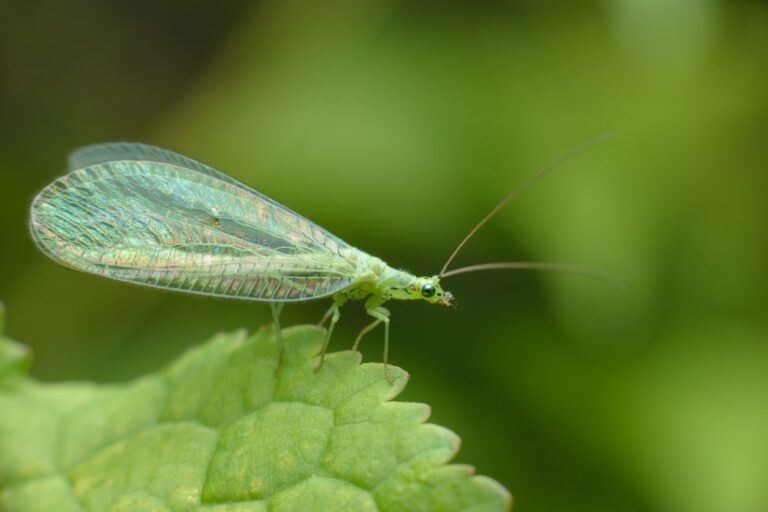
If natural remedies aren’t working, you could try a little biological warfare. Again, this is better than chemical solutions because they rely on natural means to overcome the mealybug population.
So, consider adding the mealybug’s natural predators to tackle the problem, namely:
- Cryptolaemus montrouzieri (ladybird variety)
- Green and brown lacewings
- Minute pirate bugs
- Spiders
These insects feed on mealybugs at different stages of their life cycle, which reduces the population and limits the damage they can cause.
Ladybirds are particularly favoured for attacking mealybug infestations because they eat the larvae and the bugs.
Preventing a reinfection!
Once you’ve dealt with the infestation, you’ll want to ensure these damaging critters stay gone!
So, carry out regular checks and isolate newly infected plants straight away. And avoid over-watering your plants — wet soil provides comfortable conditions for new mealybugs!
Mealybugs and ants — a match made in insect heaven
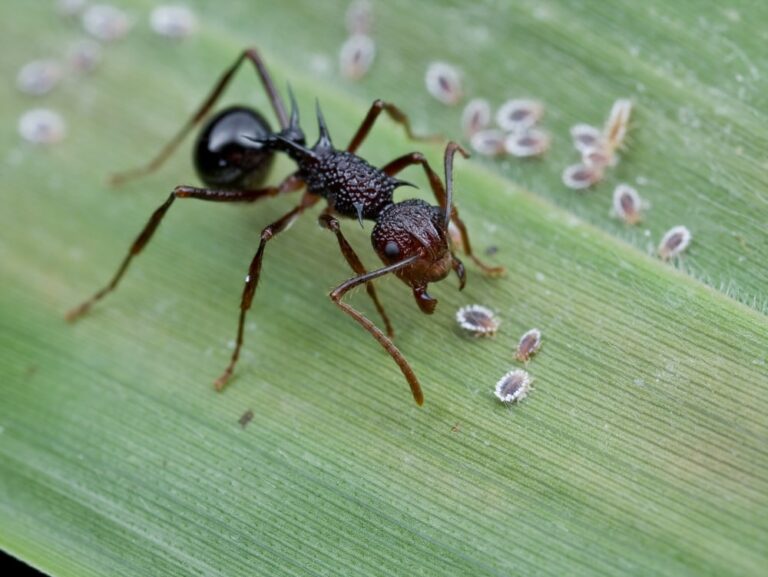
The sweet, sticky honeydew left behind after mealybugs have fed on your plants is particularly attractive to ants. And in turn, ants will protect a mealybug population because they provide an excellent food source.
Indeed, wherever there are mealybugs, there are likely to be ants, which can become problematic because ants can attack the beneficial insects you introduce.
So, another sign of mealybug infestation is the presence of a new colony of ants around your plants.
Therefore, this symbiotic relationship between ants and mealybugs can be challenging to shift. In this case, you might need to tackle the ant problem first.
Killing the ants might not be necessary, but you will want to move them. Check out our expert article on tackling an ant infestation for the humane way of tackling them.
Tips & Tricks in the fight against mealybugs
Remember, fast action is always best. With that in mind, check out our top tips and tricks to help in the fight against mealybugs.
- Isolate infested plants immediately to prevent further spread.
- Use natural remedies, such as baking soda, beneficial insects, or vinegar to combat the problem.
- Frequently check your plants for any signs of infection, including yellow and wilting leaves.
- Avoid overwatering. Wet soil is a mealybug’s ideal habitat — always use a well-draining growing medium for house and garden plants, such as well-rotted manure, potting soil, or vermiculite.
Chemical solutions to mealybug infestations
In the unlikely event that none of the natural approaches have worked, it could be time for more drastic measures.
Whenever you use a chemical pesticide, use reputable brands with green credentials. And read the instructions thoroughly before use because they can affect pond life and damage your garden’s delicate ecosystem.
Avoid spraying chemical pesticides into open blooms — they can poison bees, butterflies, and other essential pollinators. Always use a pesticide specific to the problem, and avoid buying insecticides in large quantities because they go out of date and can poison the water supply if you tip them down the drain.
Helping your plants recover after infection
There’s quite a high likelihood that the plant will die. However, it could pull through, and in these cases, keep the plant isolated until the infestation has completely disappeared. Leave it for a couple of weeks longer in isolation to make sure there’s no return.
While in isolation, give the plant an appropriate, well-diluted fertiliser, and keep the soil moist; never wet. Make sure the pot is well-draining — you don’t want the plant’s roots to sit in wet soil, as it will rot the roots and attract new mealybugs!
When it feels as though the plant is clear of the problem, it’s OK to take it out of isolation and return it to its former position.
FAQs
No. Mealybugs will seriously damage plant life but aren’t considered hazardous to human health. These tiny, woolly-looking pests feed on plant sap, which will affect a plant’s growth — but they won’t bite or harm humans. However, they can spread plant viruses and diseases from plant to plant, so you should isolate affected plants immediately.
Firstly, if you have mealybugs on your orchids, you’re likely overwatering them. Orchids require deep watering once a week and nothing more, ensuring the pot drains entirely afterwards. The roots will rot if the plant stands in water. So, minimise watering and spray 1 part vinegar to 10 parts water on affected plant limbs.
They appear to come from nowhere, but mealybugs live in the soil or can jump from plant to plant. They can also spread via the wind or on wildlife.
Any questions?
I hope I’ve answered all your questions about your mealybug infestation, but if you have any questions, don’t hesitate to get in touch or leave a comment in the comments section below!
Alternatively, check out our super-comprehensive Help & Advice section: you will surely find the answer!
Thanks for reading!
-
How to Build a DIY Greenhouse: A Practical Guide for Smart SpendersImagine extending your growing season throughout the year, nurturing tender plants regardless of the weather, and creating a personal garden sanctuary. This is precisely what a DIY greenhouse offers you. Let’s learn how to build one.Read more
-
How to Grow Eucalyptus in British GardensWith a little love and care, eucalyptus trees can thrive in English gardens. Since they don’t germinate well without proper help, there are not considered invasive. So, there is no reason not to plant them if you enjoy their looks.Read more
-
Transform Your Garden with All-Year-Round Flowering PlantsDid you know you can enjoy blooming flowers even in January? With the right selection of all year round plants, there’s no need to wait until spring to add some colour to your garden.Read more
-
How to Create a Butterfly Garden: A Simple Guide for British GardensThe UK's butterfly population includes 59 different species. These beautiful winged creatures face a steady decline because of habitat loss, pollution and changing weather patterns. Your garden can become a vital link between nature reserves and natural habitats. Let’s explore how.Read more
-
Volcanic Rock Dust for Your Garden—Application and TipsDid you know that volcanic rock dust is a brilliant organic soil improver? This article explains exactly what it's good for and how to use it properly.Read more
-
How to Use Landscape Fabric ProperlyIf weeds or erosion in your garden are troubling you, landscape fabric might be the solution. We’ll explain how and when to use it properly, just keep on reading.Read more
-
Hostas: A Complete Care GuideIf you have a north-facing garden or some shady corners on your property, hostas are the plants for you. These green delights thrive particularly well in partial to full shade and require consistently moist soil to perform at their best.Read more
-
How to Grow Grapes in Your Garden: A Simple Step-by-Step GuideGrapevines produce some tasty fruits, but often they are simply grown for their gorgeous leaves. Whatever your motivation may be, we have a guide on how to grow grapes for you.Read more
Leave a comment
Your answer will be displayed on the site and the interested party will be notified by email.
Leave a comment
Have a question or want to share your experience? Leave us a comment.

- Order by 2PM = shipped today
- 250.000+ satisfied customers!
- 60 day satisfaction guarantee

- Order by 2PM = shipped today
- 250.000+ satisfied customers!
- 60 day satisfaction guarantee

- Order by 2PM = shipped today
- 250.000+ satisfied customers!
- 60 day satisfaction guarantee

🌱 All important maintenance moments for your lawn during the year. Leave your email and we will send you the lawn calendar for free.
Enter your email
Receive the lawn calendar in the mail
Enjoy a green lawn all year round!





















Comments (0)
There are no comments yet. Well then, what are you waiting for to
Be the first to write your comment!inaugurate this pretty page?
Do you have some comments?